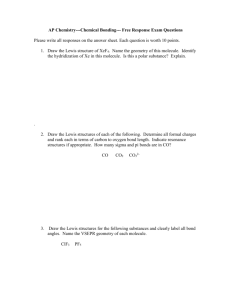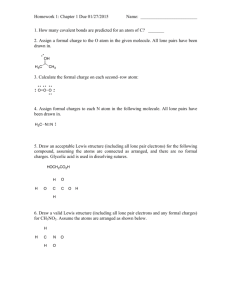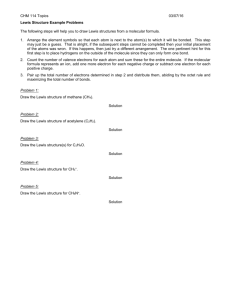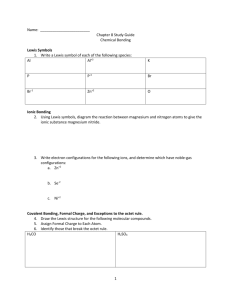VSEPR Theory - MrsLeinweberWiki
advertisement
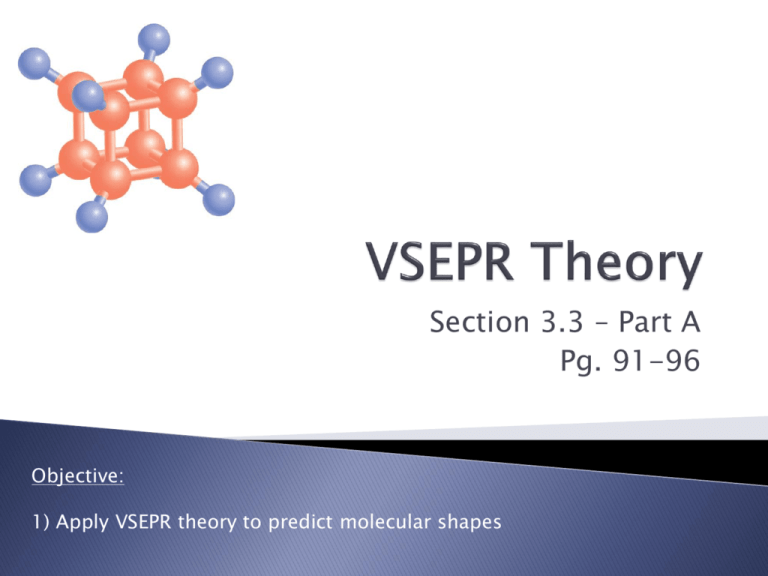
Section 3.3 – Part A Pg. 91-96 Objective: 1) Apply VSEPR theory to predict molecular shapes Stereochemistry – is the study of the 3-D spatial configuration of molecules and how this affects their reactions. Solid = in plane of page Dashed = behind (away) Wedge = ahead (toward) The shape of molecules is determined by the repulsion that happens between electron pairs The theory behind molecular shapes is called VSEPR Theory (Valence Shell Electron Pair Repulsion) General Rule: ◦ Pairs of electrons in the valence shell of an atom stay as far apart as possible because of the repulsion of their negative charges ◦ The type, number and direction of bonds to the central atom of a molecule determine the shape of the resulting molecule. So how do we predict these molecular shapes? We will be using the following compounds to analyze the 6 shapes possible ◦ BeH2(s), BH3(g), CH4(g), NH3(g), H2O(l), HF(g) To start, draw a Lewis formula for each of the molecules and then consider the arrangement of all pairs of valence electrons. ◦ (Remember – all pairs of valence e-’s repel each other and want to get as far apart as possible) Lewis Formula Bond Pairs Be 2 * Lone Total General Pairs Pairs Formula 0 2 Electron Pair Arrangement Stereochemical Formula linear X–A–X linear AX2 A is the central atom; X is another atom • This Lewis formula indicates that BeH2(s) has two bonds and no lone pairs on the central atom. • VSPER theory suggests that the two bond pairs will be farthest apart by moving to opposite sides to a bond angle of 180° • This gives the molecule a linear orientation *Exception* Beryllium does not follow OCTET RULE Lewis Formula Bond Pairs 3 B * Lone Total General Pairs Pairs Formula 0 3 AX3 Electron Pair Arrangement Stereochemical Formula trigonal planar A is the central atom; X is another atom • This Lewis formula indicates that BH3(g) has three bonds and no lone pairs on the central atom. • VSPER theory suggests that the three bond pairs will be farthest apart by moving to a bond angle of 120° to each other. • This gives the molecule a trigonal planar orientation. *Exception* - Boron Does not follow OCTET RULE Draw the Lewis Formula for BF3 Does not obey the octet rule F Trigonal Planar F F Lewis Formula Bond Pairs 4 * Lone Total General Pairs Pairs Formula 0 4 Electron Pair Arrangement AX4 tetrahedral A is the central atom; X is another atom • This Lewis formula indicates that CH4(g) has four bonds and no lone pairs on the central atom. • VSPER theory suggests that the four bond pairs will be farthest apart by arranging in three dimensions so that every bond makes an angle of 109.5° with each other. • This gives the molecule a tetrahedral orientation. Stereochemical Formula Draw the Lewis Formula for SiH4 H Tetrahedral H H H Lewis Formula Bond Pairs 3 Lone Total General Pairs Pairs Formula 1 4 AX3E Electron Pair Arrangement Stereochemical Formula tetrahedral Trigonal pyramidal * A is the central atom; X is another atom, E is a lone pair of electrons • This Lewis formula indicates that NH3(g) has three bonds and one lone pair on the central atom. • VSPER theory suggests that the four groups of e-’s should repel each other to form a tetrahedral shape (bond angle = 109.5°) • But the lone pair is very repulsive, thus pushes the atoms more to a 107.3° bond angle • This gives the molecule a trigonal pyramidal orientation. Draw the Lewis Formula for PCl3 Cl Cl Cl Trigonal pyramidal Lewis Formula Bond Pairs 2 * Lone Total General Pairs Pairs Formula 2 4 AX2E2 Electron Pair Arrangement Stereochemical Formula tetrahedral Angular (Bent) A is the central atom; X is another atom, E is a lone pair of electrons • This Lewis formula indicates that H2O(l) has two bonds and two lone pairs on the central atom. • VSPER theory suggests that the four groups of e-’s should repel each other to form a tetrahedral shape (bond angle = 109.5°) • But the TWO lone pairs are very repulsive, thus pushes the atoms more to a 105° bond angle • This gives the molecule an angular (bent) orientation. Draw the Lewis Formula for OCl2 Angular (bent) Lewis Formula H * F Bond Pairs 1 Lone Total General Pairs Pairs Formula 3 4 AXE3 Electron Pair Arrangement Stereochemical Formula Linear (Tetrahedral) A is the central atom; X is another atom, E is a lone pair of electrons • This Lewis formula indicates that H2O(l) has two bonds and two lone pairs on the central atom. • VSPER theory suggests that the four groups of e-’s should repel each other to form a tetrahedral shape (bond angle = 109.5°) • But since there are only two atoms with one covalent bond holding them together, by definition, the shape is linear, as is the shape of every other diatomic molecule. Draw the Lewis Formula for HCl VSEPR theory describes, explains, and predicts the geometry of molecules by counting pairs of electrons that repel each other to minimize repulsion. The process for predicting the shape of a molecule is summarized below: Step 1: Draw the Lewis formula for the molecule, including the electron pairs around the central atom. Step 2: Count the total number of bonding pairs (bonded atoms) and lone pairs of electrons around the central atom. Step 3: Refer to Table 7, and use the number of pairs of electrons to predict the shape of the molecule. Pg. 95 Draw the Lewis and stereochemical formulas for a sulfate ion, SO42- and predict the shape ◦ See pg. 95 Draw the Lewis and stereochemical formulas for a chlorate ion, ClO3- and predict the shape ◦ See pg. 96 On your own: Pg. 96 #3 It is important to remember that a double or triple bond is one bond, and to treat it as such, when predicting the VSEPR shapes of molecules. Example: Predict the shape of C2H4(g) ◦ Draw the Lewis formula for the molecule H H H H ◦ Count the # of pairs of e-’s around the central carbon atoms. The carbon atoms have 3 bonds (2 single, 1 double) and no lone pairs. This is the same as a trigonal planar configuration. Practice: Predict the shape for C2H2(g). Answer: See pg. 97 1) Finish pg. 96 #1-3 2) Pg. 98 #6-7 (Multiple Bond Practice) ◦ For 7 c, d, e - If there is more than one central atom involved, tell me the shape around each of the central atoms ◦ Example: trigonal planar—first two carbons tetrahedral—third carbon 3) Pg. 104 #1, 2, 3 #2: If there is more than one central atom involved, tell me the shape around each of the central atoms Draw the Lewis Formula for PCl3

